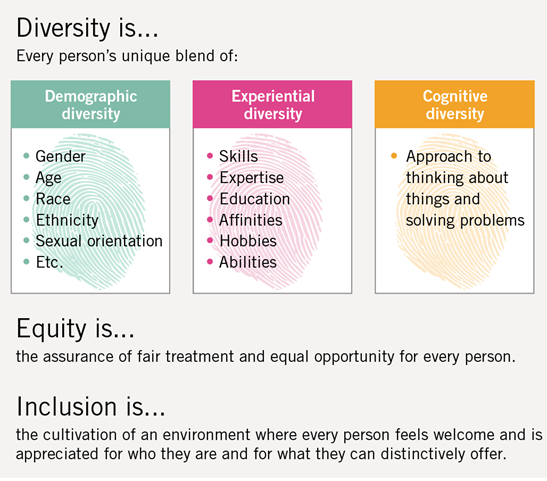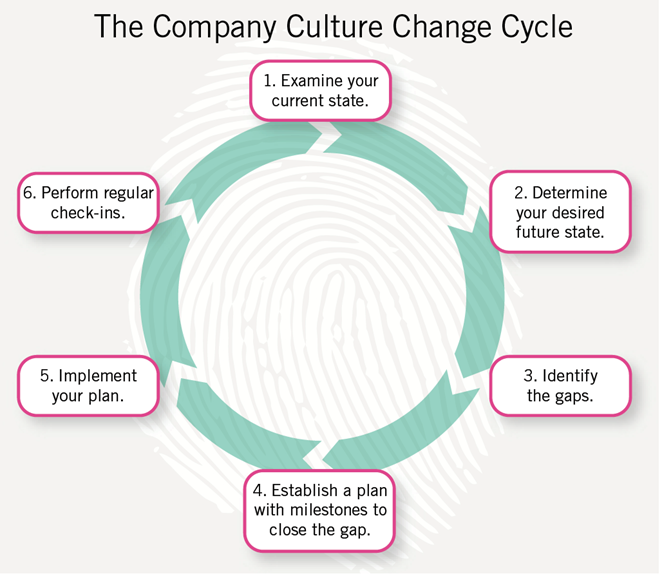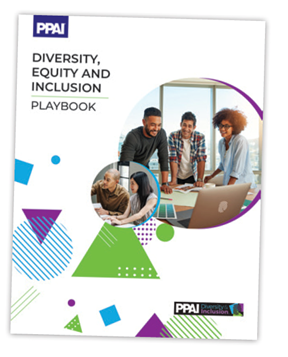Think Beyond Diversity. Focus On Culture.

First in a three-part series.
For decades, we have heard talk about the importance of diversity. There have been countless articles written about why companies need to put measures in place that ensure hiring practices bring people into the organization who are considered diverse. Whether the motivation is fear of discrimination lawsuits, or an attempt to show that you’re “doing your part” to contribute to a diverse workplace, diversity initiatives cannot succeed as stand-alone initiatives. They merely scratch the surface of more deeply engrained organizational behaviors that must be addressed for real change to occur.
Diversity acknowledges that we all have differences, which makes every human being uniquely diverse. Diversity is more than just ethnicity or gender, and it’s more than just demographics. It encompasses every person’s unique blend of demographic characteristics (gender, age, race, ethnicity, sexual orientation, religion, etc.), experiences (skills, expertise, education, affinities, hobbies, abilities) and perspectives (approach to thinking about things and solving problems). All three types of diversity shape a person’s identity, and all these differences matter.

But the concept of diversity itself has carried so much emphasis that it overshadows two crucial concepts—equity and inclusion. Equity is the assurance of fair treatment and opportunity for every person. It’s built upon the principle of equality; here is what differentiates the two: equality says that everyone gets the same, while equity says that each person gets what they need to succeed. It acknowledges that people do not all start from the same place, but that every person deserves a fair opportunity to develop, contribute and succeed.
Inclusion is the cultivation of an environment where every person feels welcome and is appreciated for who they are and for what they can distinctively offer. It means that everyone contributes to the success of the business and the people around them.
These three concepts—diversity, equity and inclusion—are distinct yet interdependent. Without one, you cannot have the others. If you make decisions with the fair and impartial lens of equity, you are more likely to give someone an opportunity that you may not have otherwise provided. You have given them an opportunity to add value by contributing to an environment of inclusion—and inclusion attracts diversity.
To make any positive shift in your workplace diversity, it is important to take an honest look at your personal attitudes and beliefs about these terms, and to reframe your understanding of them. Whether you are an employer, a manager or a leader of people, your understanding of these terms impacts the way you manage, lead, hire and engage with others. It impacts your relationships.
Life and business are about relationships. When you sell a product or service, you are building a relationship with someone. When you hire an employee, you are establishing a relationship with that person. In any relationship, both people have an innate desire to be valued and respected.
Amid customer demands, project deadlines and budgets, it is easy to lose sight of the relational aspect of business transactions. But when you build diversity, equity and inclusion into your business practices, it demonstrates the value that you place on the human side of business. Pouring care and attention into the needs and successes of the people within your organization, you can have a greater impact on your bottom line than if you focus solely on metrics, productivity and efficiency. When the people within your organization feel valued and supported, they succeed. When they succeed, they produce better-quality work, care more about customers and demonstrate greater loyalty to the organization. These steps breed customer loyalty and decrease employee turnover, a significant expense for any organization.

The things you do internally work together to create an equitable, inclusive environment that attracts diverse employees. Hiring diverse individuals into an environment that lacks equity and inclusion and hoping they will succeed does not work. Hoping their presence will help make the environment more inclusive does not work either. It sets your “diverse hire” up for failure. Rather, focus on fostering an environment that enables diverse employees to succeed.
So, before you begin hiring for diversity, focus on inclusion. How? Start by examining your company culture, which consists of the values, goals and norms that drive behavior in a group or organization. While there are countless tactics and initiatives a company may take to move the needle on diversity and inclusion, the most powerful first step is to define your company’s culture. Whether your company has one employee or 1,000 employees, your company has culture. It defines who the company is and drives your business forward.
More specifically, focus on your company values—the important and lasting beliefs shared by the members of an organization about what is good and desirable. Has your company defined its values? Do your employees know what those values are? If you have defined company values, when is the last time you checked in to determine whether your company has a healthy, thriving company culture?
Start by assessing your company’s culture as it is today:
- What are the values, goals and norms that drive your company?
For each item you list, would it be observable by someone new to the company or by a first-time customer? Do you like what you see? If not, take some time to think about your ideal company culture. Or, maybe the organization has been operating with implicit or unspoken beliefs and it is simply time to make them clearer and more defined.
Comparing your current reality with your ideal company culture, identify the gaps where your current reality and the ideal are disconnected. This analysis will show you where you can focus your efforts. Where there are gaps, identify what it will take to close the gaps, then establish a plan with milestones and implement your plan.
After successful implementation, be sure to perform regular check-ins to maintain the health of your organization’s culture. A best practice is to use an ongoing approach to ensure all internal communication and organizational activities or initiatives align with your established values and goals. If they are misaligned, examine the underlying intent or motive for the communication or initiative. You might also consider completing an annual assessment of your company culture to evaluate the durability of your defined values and goals. Regardless of your chosen approach, remember that your company culture will thrive when it is well-maintained and cared for.
With your company values as a guide, you can focus on ways to foster inclusion within your organization. As a result, your employees will thrive, and diversity will flourish within your organization and your client roster.
Part 2 in the May issue will share strategies for creating an inclusive environment.
Part 3 in the June issue will focus on bringing diversity into the organization.
Download PPAI’s New Playbook

For many, diversity, equity and inclusion may seem an overwhelming concept to implement in business, but there are practical, powerful steps you can take for your organization. To begin your diversity, equity and inclusion journey today, download your copy of PPAI’s Diversity, Equity And Inclusion Playbook at ppai.org/advocacy/diversity-inclusion.
–––––––––––––––––––––––––––––––––––––––––––––––––––––––––––
Julie Kwan is the manager of diversity and learning engagement at PPAI.
If your company has a story to tell about building a strong company culture, email Julie Kwan at juliek@ppai.org.

